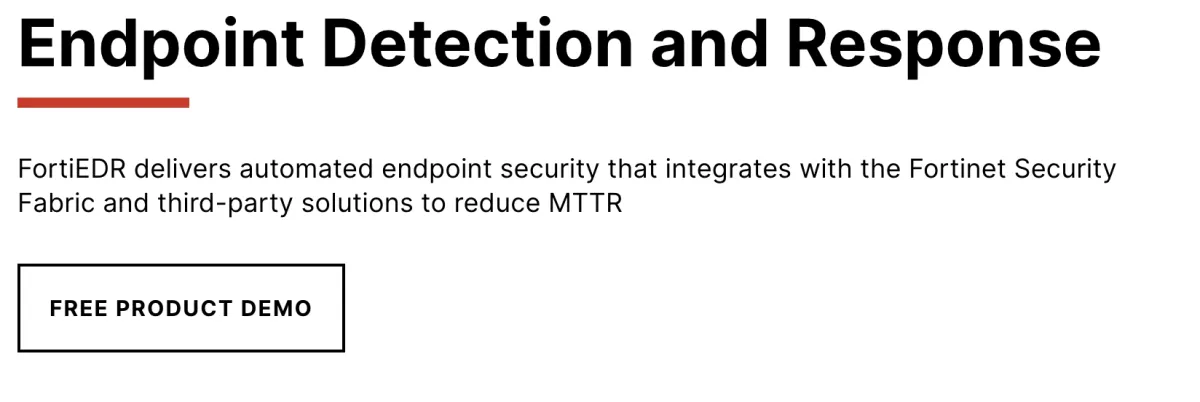Endpoint Detection and Response (EDR) solutions, also known as endpoint detection and threat response (EDTR), provide real-time monitoring, threat detection, and response functionalities at the endpoint level, allowing organizations to proactive threat hunting at their endpoints.
The EDR tools market is characterized by a multitude of vendors offering a variety of functionalities and features. This article examines the top EDR solutions in the market by assessing their features and pricing models.
Quick summary of the best EDR tools
The vendors listed in the table are organized in alphabetical order.
| Vendor | Starting price/year | Free trial | Operating System |
|---|---|---|---|
| Bitdefender | Not shared publicly | 30-day | Windows, Mac, Linux |
| Cisco AMP | Not shared publicly | 30-day | Windows, Mac, Linux, and Android |
| Cortex XDR | $14,000 | ❌ | Windows, Mac, Linux |
| Cynet | Not shared publicly | ❌ | Cynet 360 Mobile, Windows, Mac, Linux |
| Cybereason EDR | Not shared publicly | ❌ | Windows, Mac, Linux, Android and IOS |
| FortiEDR | Not shared publicly | 30-day | Windows, Mac, Linux |
| Huntress | Not shared publicly | ✅ | Windows, macOS |
| RSA NetWitness Endpoint | $7,900.00 | ❌ | Linux/Unix, CentOS 7 |
| SentinelOne Singularity Endpoint | $15,500 | Not shared publicly | Windows, macOS |
| VMware Carbon Black | Not shared publicly | ✅ | Windows, Mac, Linux |
Comparing top EDR tools: Feature-based comparison
1. Cynet EDR
Cynet 360 security platform is a comprehensive solution that offers security tools, including Next-Generation Antivirus (NGAV), Endpoint Detection and Response (EDR), User and Entity Behavior Analytics (UEBA), deception technology, network monitoring, and endpoint protection.

Key features:
- Data correlation: Utilizes the integrated capabilities of the security platform to analyze data from endpoints, enhancing the transparency of network, user, and endpoint actions, reducing false positives.
- Automated response: Triggers automatic responses to security incidents, like isolating an endpoint to prevent malware dissemination. It also supports tailored remediation processes that automatically execute when recurring cyber threats are detected.
- Real-Time and historical visibility: Offers real-time and historical insight into endpoint activities, allowing for both immediate and historical analysis of activities.
Read more: Network security software.
2. Bitdefender EDR
Bitdefender is a cybersecurity company that provides a range of endpoint security solutions, including antivirus, container security, and EDR. The company’s solutions monitor both network and endpoint device environments to promptly identify unusual activities. Its EDR solution capabilities are enhanced by analytics that aggregate and correlate data across multiple endpoints, with additional support from context-rich data provided by the XDR (Extended Detection and Response) module.
Bitdefender EDR is designed to complement and enhance any existing Endpoint Protection Platform (EPP), offering versatile deployment options that can seamlessly transition to Managed Detection and Response services.

Key features:
- Endpoint data collection: Monitors network and endpoint devices- such as desktops, laptops, and servers- to detect and block malicious activity early on.
- Cross-endpoint detection and response: By collecting and analyzing data across various endpoints, like workstations, servers, and containers, the EDR system can integrate events to identify broader security incidents.
- Incident investigation: Assists in sorting, examining, and responding to all security events observed and recorded for the managed company over the past 90 days.
3. RSA NetWitness Endpoint
RSA NetWitness is a threat detection platform designed to assist Security Operation Centers (SOCs) in identifying and resolving known threats. The platform delivers insights by analyzing network traffic (packets), logs, and endpoint data, enabling a comprehensive approach to threat management. NetWitness Endpoint is an endpoint detection and threat response tool that enables security teams to identify emerging, known and unknown threats. Users can choose to install endpoint agents on specific versions of Linux and Mac operating systems.

Key features:
- Behavior-based detection: Integrates endpoint-based User and Entity Behavior Analytics (UEBA) that assesses and ranks incidents according to their potential threat level.
- Endpoint investigation: Analyzes data from packets, logs, endpoints, and entity and user behavior analytics to detect suspicious system behavior, both internal and external, to the security and the IP infrastructure.
- Policy-based Centralized Content Management (CCM): Administrators can centrally manage and implement security policies, which involves establishing restrictions on file access, specifying required data encryption levels, and identifying behaviors that may be considered potentially malicious.
4. Cisco AMP for Endpoints
Cisco Secure Endpoint, previously known as AMP for Endpoints, incorporates the built-in Cisco SecureX. As a cloud-native platform, it offers capabilities that extend beyond traditional Endpoint Protection Platforms (EPP) and Endpoint Detection and Response (EDR), by facilitating the orchestration and execution of threat detection and response.

Key features:
- USB device control: Allows organizations to monitor and manage the use of USB devices, including Windows Portable Devices (WPD), giving users visibility into the devices connected to their endpoints.
- Integrated XDR capabilities: Identify, prioritize, and investigate threats while mitigating attacks through native integration with a XDR solution. This strategy provides comprehensive insight by collecting telemetry data from Cisco’s security solutions and third-party tools, covering networks, endpoints, email, and cloud environments.
- Endpoint isolation: Allows organizations to control incoming and outgoing network traffic on Windows computers, helping to prevent risks such as data theft and the spread of malware.
- Dynamic file analysis: Sends files that match specified criteria to a “sandbox” for deeper analysis and allows users to manually submit executable files whose safety is uncertain for further examination.
5. Cortex XDR
Cortex Extended Detection and Response (XDR), developed by Palo Alto Networks, is an endpoint security solution that utilizes machine learning to detect and address threats across various aspects of an enterprise, including networks, cloud infrastructure, and endpoints. Cortex XDR license includes several components:
- Cortex XDR Prevent: This feature offers a comprehensive defense system with multi-layer protection and detection capabilities. It blocks various threats including malware, ransomware, behavioral-based attacks, and exploit attempts. Additionally, it includes functionalities such as device control, firewall protection, and disk encryption.
- Cortex XDR Pro per Endpoint: This license provides customized endpoint data collection and integration with third-party logs.
- Cortex XDR Cloud per Host: This is tailored for cloud-based endpoint protection and detection. It includes specialized endpoint data collection and integration with third-party logs. Moreover, it extends support for Kubernetes environments.

Key features:
- Identity-centric threat detection: Targets the methods, techniques, and procedures used for initial access. Advanced identity-based threat detection analytics, such as insider threat detection, can be added as optional extras.
- Extensive visibility encompasses all areas: Includes networks, cloud platforms, third-party integrations, and identity sources, not just limited to endpoints.
6. FortiEDR
FortiEDR, a component of the SECOps platform, is an Endpoint Detection and Response (EDR) solution that offers comprehensive endpoint security functionalities across various domains, including workstations, servers, cloud workloads, and operational technology (OT) systems. It provides support for Microsoft Windows, Mac OS, and Linux virtual desktop infrastructure (VDI) environments.

Key features:
- Cloud native management console: The dashboard offers an intuitive interface that equips security analysts with prevention, detection, and incident response capabilities. It simplifies the process of comprehending their entire environment.
- Automated tax surface policies: FortiEDR empowers security teams to identify and monitor applications along with their CVE status. Additionally, it provides proactive policies based on risk assessment to prevent the exploitation of vulnerabilities within systems and applications.
- Threat hunting: Offers tools for security teams to hunt throughout their environments. Telemetry collected is tagged with relevant MITRE ATT&CK tactics, helping the analysis and understanding of potential threats.
7. Huntress
Huntress Labs provides an endpoint security offering called Huntress Managed EDR, tailored for small and medium-sized enterprises. This managed EDR service is managed by security professionals from Huntress Labs.

Key features:
- Assisted remediation: Performs customized corrective actions as supplied by Huntress automatically.
- Behavioral analytics: Analyzes all running processes within a system, and upon identifying any suspicious activity, it proceeds to gather additional logs and relevant data pertaining to that activity.
- Managed antivirus: Using the Huntress dashboard’s multi-tenant support, Managed AV allows users to manage detections and events, track scans and protections, and implement remediation actions across all safeguarded endpoints.
8. SentinelOne Singularity Endpoint
SentinelOne Singularity platform is a centralized hub merging the data, access, control, and integration aspects of its endpoint protection (EPP), endpoint detection and response (EDR), IoT security, and cloud workload protection (CWPP). Singularity XDR incorporates threat intelligence sourced from both third-party feeds and proprietary channels for advanced threat detection.

Key features:
- On-execution behavioral technologies: Unlike traditional endpoint security solutions, this approach enables companies to monitor and analyze the behavior of processes and applications as they execute in real time.
- Threat hunting: Within the platform are functionalities such as Storyline, which automates event correlation tasks, with root cause analysis.
9. Cybereason EDR
Cybereason, as an XDR (Extended Detection and Response) company, offers prevention, detection, and response solutions. Cybereason’s EDR platform integrates all information regarding each cyberattack into a unified visual depiction known as a MalOp (short for malicious operation).

Key features:
- Detect advanced persistent threats: Gathers data from each endpoint across various operating systems and employs behavioral analysis and data correlation across devices to provide a comprehensive overview of activities within an environment.
- Remediation: The Cybereason Defense platform provides remediation capabilities, allowing analysts to carry out various actions to address threats. These actions include isolating machines, terminating processes, and eliminating persistence.
10. VMware Carbon Black EDR
Carbon Black EDR is a solution tailored for security operations centers (SOCs) and incident response (IR) teams, offering incident response and threat hunting functionalities specifically suited for offline environments or on-premises setups.

Key features:
- Centralized access: Provides centralized access to endpoint data that is continuously recorded.
- Live response: Assists security teams in investigating and responding to malicious activities occurring at remote endpoints.
- Attack chain visualization: The graphical representation of the series of events or actions taken by an attacker aids security analysts in comprehending the progression of an attack, starting from its inception to the ultimate compromise.
What is an EDR tool?
Endpoint Detection and Response (EDR) tool is an endpoint security solution designed to monitor and protect endpoints, including computers, servers, and mobile devices, within a network. EDR security solutions record and archive endpoint-system behaviors, employ diverse data analysis methods to identify unusual system conduct and offer recommendations for remediation.
How do EDR tools work?
Endpoint Detection and Response (EDR) solutions perform continuous monitoring and recording of activities and events occurring on endpoints. Here’s an overview of the typical operations of EDR tools:
- Data Collection: EDR tools gather telemetry data from endpoints, including details on system processes, network connections, file modifications, and user activities.
- Behavioral analysis: The collected data undergoes analysis employing various techniques, including signature-based detection, behavioral analytics, and anomaly detection, aimed at identifying patterns indicative of malicious activities.
- Threat detection: EDR tools cross-reference the analyzed endpoint data with known threat indicators to detect potential threats.
- Alerting and reporting: Upon detecting suspicious activities, EDR tools generate alerts and notifications to inform security analysts, providing detailed information about the identified threat.
- Incident investigation: Security teams utilize EDR tools to delve into security incidents, accessing logs and historical endpoint data for investigation purposes.
- Response and remediation: Actions taken may involve isolating compromised endpoint threats from the network or terminating malicious processes as part of the response and remediation process.
Important network security software to combine with EDR tools
Network security audit tools: Identify threats, vulnerabilities, and malicious activity to help companies mitigate cyber attacks and follow compliance with regulations.
NCCM software: Monitor information about your organization’s network devices by documenting network device configurations.
DSPM vendors: Provide network visibility into where to find sensitive data, who has access to it, and how it has been used across the cloud.
Network security policy management solutions (NSPM): Protect network infrastructure using firewalls and security policies against all threats.
SDP software: Deliver a software-defined perimeter (SDP) across the cloud to determine who gets access to what resources.
DLP software: Minimize data breach and data loss by controlling access to sensitive data.
USB blocking software: Control access rules for USB reading and writing.
If you have further questions, reach us:


Comments
Your email address will not be published. All fields are required.